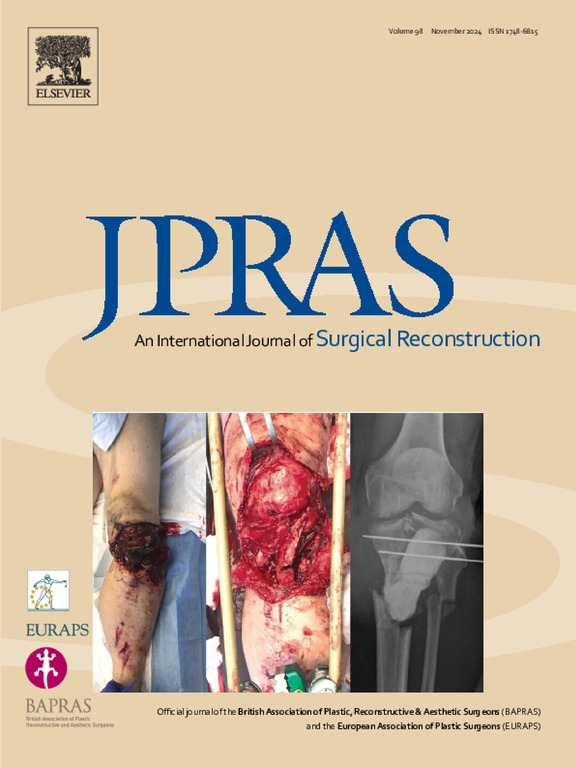Fat-augmented latissimus dorsi flap and implant-based latissimus dorsi flap: A systematic review
IF 2
3区 医学
Q2 SURGERY
Journal of Plastic Reconstructive and Aesthetic Surgery
Pub Date : 2025-04-08
DOI:10.1016/j.bjps.2025.04.003
引用次数: 0
Abstract
Background
Implant-related concerns have increased the interest in the use of complete autologous latissimus dorsi (LD) flaps in breast reconstruction. To achieve the desired volume without implants, autologous fat transfer can be used to enhance the breast size. Fat-augmented LD (FALD) flap is an alternative technique for volume enhancement that incorporates autologous fat grafting, thereby replacing the need for implants.
Methods
A systematic literature search was performed according to the preferred reporting items for systematic reviews and meta-analyses protocol using the PubMed, Embase, Web of Science, Scopus, CENTRAL, ICTRP and Clinicaltrials.gov databases. Data on patient-reported outcomes and clinical outcomes were extracted.
Results
The electronic database search identified 2606 records, among which 71 met the inclusion criteria. A total of 67 articles were included in the statistical analysis, reporting on 1185 FALD and 3958 implant-based LD flap breast reconstructions. Patient demographics and treatment characteristics were generally comparable across studies. The reported minor complication rate for implant-based LD was 23.9% (95% confidence intervals [CI]: 18.2–30.6%) and 25.1% (95% CI: 17.5–34.5%) for FALD. The major complication rate was 2.4% (95% CI: 1.3–4.4%) in the FALD group and 4.9% (95% CI: 3.4–7.2%) in the implant-based LD group.
Conclusion
This systematic review provides an overview of the current literature on both techniques and presents the available data on complication rates and patient-reported outcomes. The findings suggest that FALD is a safe alternative, with a potential trend towards lower major complication rates. Further high-quality comparative studies are needed to enable direct comparison and to draw more definitive conclusions.
脂肪增强背阔肌皮瓣和植入式背阔肌皮瓣:系统综述
背景:植物相关的担忧增加了使用完整的自体背阔肌(LD)皮瓣进行乳房重建的兴趣。为了在没有植入物的情况下达到理想的体积,自体脂肪移植可以用来增加乳房的大小。脂肪增强LD (FALD)皮瓣是一种可替代的体积增强技术,它结合了自体脂肪移植,从而取代了对植入物的需求。方法采用PubMed、Embase、Web of Science、Scopus、CENTRAL、ICTRP和Clinicaltrials.gov数据库,根据系统评价和meta分析方案的首选报告项目进行系统文献检索。提取患者报告的结果和临床结果的数据。结果电子数据库检索到2606条记录,其中71条符合纳入标准。统计分析共纳入67篇文献,报道了1185例FALD和3958例基于植入物的LD瓣乳房重建。不同研究的患者人口统计学和治疗特征一般具有可比性。据报道,基于种植体的LD的轻微并发症发生率为23.9%(95%可信区间[CI]: 18.2-30.6%), FALD为25.1% (95% CI: 17.5-34.5%)。FALD组的主要并发症发生率为2.4% (95% CI: 1.3-4.4%),种植体LD组的主要并发症发生率为4.9% (95% CI: 3.4-7.2%)。本系统综述综述了目前关于这两种技术的文献,并提供了有关并发症发生率和患者报告结果的现有数据。研究结果表明,FALD是一种安全的替代方案,具有降低主要并发症发生率的潜在趋势。需要进一步进行高质量的比较研究,以便进行直接比较并得出更明确的结论。
本文章由计算机程序翻译,如有差异,请以英文原文为准。
求助全文
约1分钟内获得全文
求助全文
来源期刊
CiteScore
3.10
自引率
11.10%
发文量
578
审稿时长
3.5 months
期刊介绍:
JPRAS An International Journal of Surgical Reconstruction is one of the world''s leading international journals, covering all the reconstructive and aesthetic aspects of plastic surgery.
The journal presents the latest surgical procedures with audit and outcome studies of new and established techniques in plastic surgery including: cleft lip and palate and other heads and neck surgery, hand surgery, lower limb trauma, burns, skin cancer, breast surgery and aesthetic surgery.

 求助内容:
求助内容: 应助结果提醒方式:
应助结果提醒方式:


